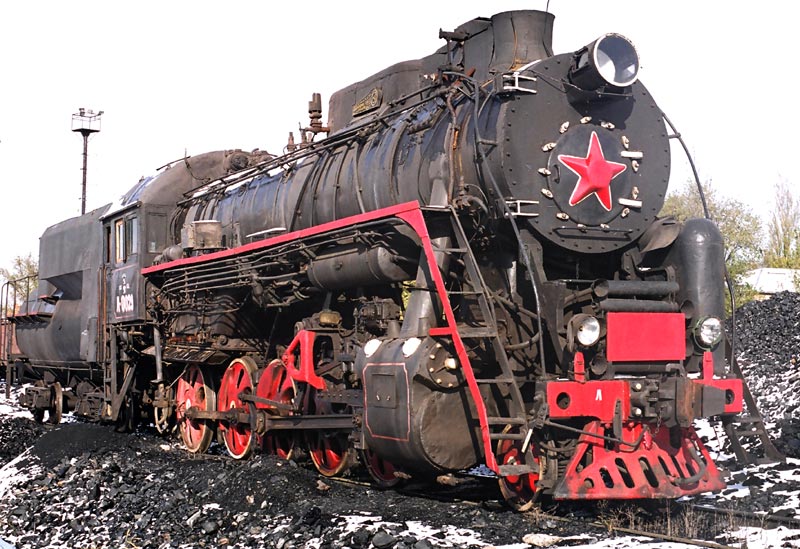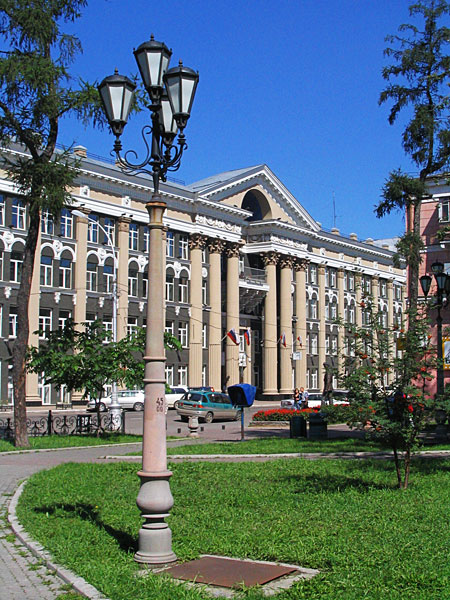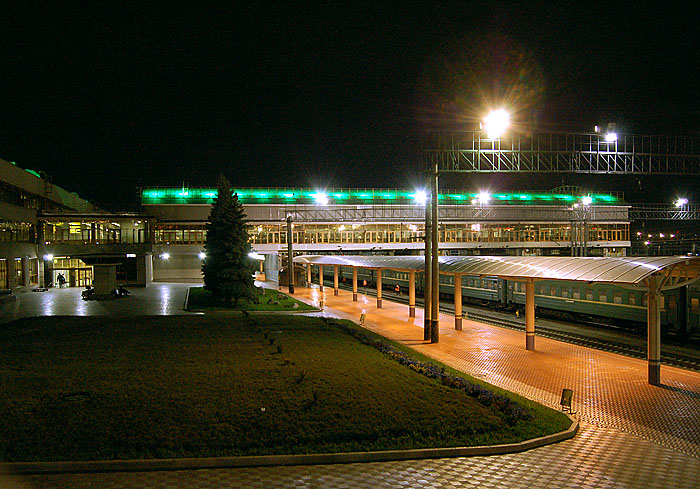|
Russian Locomotive Class LV
The Soviet locomotive class LV (russian: ЛВ) was a Soviet main freight steam locomotive type. Between 1952 and 1956, 522 locomotives were built. Development The class LV locomotive was designed as a successor to the class L 2-10-0, which had been a successful design developed during World War II. However, by the late 1940s some drawbacks to the design, including poor operating qualities when operating in reverse, had become apparent. In 1949 the General Directorate of the Ministry of Railways authorized the development of a new 2-10-2 locomotive. Voroshilovgrad Works in Voroshilovgrad, Ukrainian SSR (now Luhansk, Ukraine), began designing the new locomotive and the prototype was ready in 1951. Initially the class was designated OR18, with the prototype locomotive numbered OR18-01, but the designation was later changed to class LV. In addition to a new boiler and firebox, advancements over the class L included a centralized lubrication system, pneumatic grates, power rever ... [...More Info...] [...Related Items...] OR: [Wikipedia] [Google] [Baidu] |
Voroshilovgrad Locomotive Factory
Luhanskteplovoz ( uk, Луганськтепловоз or Luhansk Locomotive Works), earlier known as Voroshilovgrad Locomotive Works is a large industrial company in Luhansk, Ukraine, manufacturing locomotives, multiple unit trains (both electric and diesel) as well as other heavy equipment. Due to the War in Donbas it has not been operating since March 2015. According to media reports, by late 2015 the works were looted and completely inoperational. The company was founded in 1896 as Russische Maschinenbaugesellschaft Hartmann in Lugansk (Russian Engineering Company Hartmann in Luhansk) and renamed October Revolution Locomotive Factory in November 1922.Maurice Railroad Equipment Industry List (MREIL) List of European locomotive and rolling stock manufacturers collated by Maurice Jansen, via ''railfaneurope.net'' ... [...More Info...] [...Related Items...] OR: [Wikipedia] [Google] [Baidu] |
Roller Bearings
In mechanical engineering, a rolling-element bearing, also known as a rolling bearing, is a bearing (mechanical), bearing which carries a load by placing rolling elements (such as balls or rollers) between two concentric, Groove (engineering), grooved rings called Race (bearing), races. The relative motion of the races causes the rolling elements to rolling, roll with very little rolling resistance and with little sliding (motion), sliding. One of the earliest and best-known rolling-element bearings are sets of logs laid on the ground with a large stone block on top. As the stone is pulled, the logs roll along the ground with little sliding friction. As each log comes out the back, it is moved to the front where the block then rolls on to it. It is possible to imitate such a bearing by placing several pens or pencils on a table and placing an item on top of them. See "bearing (mechanical), bearings" for more on the historical development of bearings. A rolling element rotary bea ... [...More Info...] [...Related Items...] OR: [Wikipedia] [Google] [Baidu] |
Krasnoyarsk Railway
Krasnoyarsk Railway (russian: link=no, Красноярская железная дорога) is a subsidiary of the Russian Railways headquartered in Krasnoyarsk and serving the south of Siberia. Main information Its mainline is a link in the Trans-Siberian Railway crossing the Krasnoyarsk Krai and Khakassia. It is wedged between the West Siberian Railway (to the west) and East Siberian Railway (to the east). Its length is estimated at 3157,9 km (as of 2009). History Regular traffic on the road between Novonikolaevsk (now Novosibirsk) and Krasnoyarsk opened in 1898, between Krasnoyarsk and Irkutsk in 1899 after the completion of the construction of the largest railway bridge in Asia over the Yenisei. In the period from January 1904 to October 1905 Siberian railway played a big role in providing military transportation during the Russo-Japanese war. In 1926 built the line Achinsk – Abakan (Achinsk-Minusinsk railway). In 1949 began the construction of the line Novokuzne ... [...More Info...] [...Related Items...] OR: [Wikipedia] [Google] [Baidu] |
East Siberian Railway
The East Siberian Railway () is a railway in Russia (a branch of the Russian Railways and a part of the Trans-Siberian Railway), which runs across Irkutsk Oblast, Chita Oblast, Buryatia, and Yakutia. The railway administration is located in Irkutsk. The East Siberian Railway borders with the Krasnoyarsk Railway (railway station of Yurty), Trans-Baikal Railway (railway station of Petrovsky Zavod), and Baikal Amur Mainline (railway station of Lena-Vostochnaya). To the south, the East Siberian Railway runs close to the Russo-Mongolian border (railway station of Naushki). As of 2008, the total working length of the East Siberian Railway was ; number of employees – 46,233 (61,418 in 2005); net weight hauled – 76 million tonnes (75.934 million in 2005); long-distance passenger traffic – 3.6 million people (4.838 million in 2005); suburban traffic – 29 million people (26.225 million in 2005). Annual cargo turnover is 278 million tonnes. The East Siberian Railway consists of ... [...More Info...] [...Related Items...] OR: [Wikipedia] [Google] [Baidu] |
South Urals Railway
The Yuzhno–Uralskaya Railway (Южно-Уральская железная дорога; "South Ural Railway") is a subsidiary of the Russian Railways headquartered in Chelyabinsk. It operates the railways in the Orenburg, Chelyabinsk, Kurgan, and Sverdlovsk regions as well as the Republic of Bashkortostan. Their total length is 4,935 km. Several stretches of the railway cross the territory of what is now Kazakhstan. The railway was part of the Ural, or Perm, Railway until 1934. The Chelyabinsk–Yekaterinburg line was constructed in the 1880s and early 1890s as part of the Trans-Siberian Railway (its southern route). The Orenburg–Samara line was opened in 1877. Several other lines were added during Joseph Stalin's industrialization to serve the Magnitogorsk Iron and Steel Works Magnitogorsk Iron and Steel Works (russian: Магнитогорский металлургический комбинат, Magnitogorskiy Metallurgicheskiy Kombinat), abbreviated as MMK, is an iron ... [...More Info...] [...Related Items...] OR: [Wikipedia] [Google] [Baidu] |
People's Republic Of China
China, officially the People's Republic of China (PRC), is a country in East Asia. It is the world's most populous country, with a population exceeding 1.4 billion, slightly ahead of India. China spans the equivalent of five time zones and borders fourteen countries by land, the most of any country in the world, tied with Russia. Covering an area of approximately , it is the world's third largest country by total land area. The country consists of 22 provinces, five autonomous regions, four municipalities, and two Special Administrative Regions (Hong Kong and Macau). The national capital is Beijing, and the most populous city and financial center is Shanghai. Modern Chinese trace their origins to a cradle of civilization in the fertile basin of the Yellow River in the North China Plain. The semi-legendary Xia dynasty in the 21st century BCE and the well-attested Shang and Zhou dynasties developed a bureaucratic political system to serve hereditary monarchies, or dyna ... [...More Info...] [...Related Items...] OR: [Wikipedia] [Google] [Baidu] |
China Railways QJ
The QJ () was a type of heavy freight steam locomotive introduced in 1956 by the China Railway. The majority were built by Datong Locomotive Factory. The prototypes and early production of the class were designated HP (), being redesignated as FD () class during the Cultural Revolution, before becoming the QJ class in 1971. The class became the primary mainline freight locomotive on the Chinese rail network by the 1980s. Manufactured until 1988, they were displaced by diesel locomotives in 2005. A total of 4,717 were produced. After the end of steam on the national Chinese railway network many QJ locomotives were used on industrial lines, as well as on the Jitong railway. Several members of the class have been preserved. History and design 42 prototypes were built by Dalian locomotive works, Tangshan locomotive works, and Shenyang, Mudanjiang, Changchun and Datong locomotive factories between 1956 and 1960. Originally the locomotives were designated as the HP (''Heping'' mean ... [...More Info...] [...Related Items...] OR: [Wikipedia] [Google] [Baidu] |
Electric Locomotives
An electric locomotive is a locomotive powered by electricity from overhead lines, a third rail or on-board energy storage such as a battery or a supercapacitor. Locomotives with on-board fuelled prime movers, such as diesel engines or gas turbines, are classed as diesel-electric or gas turbine-electric and not as electric locomotives, because the electric generator/motor combination serves only as a power transmission system. Electric locomotives benefit from the high efficiency of electric motors, often above 90% (not including the inefficiency of generating the electricity). Additional efficiency can be gained from regenerative braking, which allows kinetic energy to be recovered during braking to put power back on the line. Newer electric locomotives use AC motor-inverter drive systems that provide for regenerative braking. Electric locomotives are quiet compared to diesel locomotives since there is no engine and exhaust noise and less mechanical noise. The lack of rec ... [...More Info...] [...Related Items...] OR: [Wikipedia] [Google] [Baidu] |
Diesel Locomotive
A diesel locomotive is a type of railway locomotive in which the prime mover is a diesel engine. Several types of diesel locomotives have been developed, differing mainly in the means by which mechanical power is conveyed to the driving wheels. Early internal combustion locomotives and railcars used kerosene and gasoline as their fuel. Rudolf Diesel patented his first compression-ignition engine in 1898, and steady improvements to the design of diesel engines reduced their physical size and improved their power-to-weight ratios to a point where one could be mounted in a locomotive. Internal combustion engines only operate efficiently within a limited power band, and while low power gasoline engines could be coupled to mechanical transmissions, the more powerful diesel engines required the development of new forms of transmission. This is because clutches would need to be very large at these power levels and would not fit in a standard -wide locomotive frame, or wear too quic ... [...More Info...] [...Related Items...] OR: [Wikipedia] [Google] [Baidu] |
20th Congress Of The Communist Party Of The Soviet Union
The 20th Congress of the Communist Party of the Soviet Union was held during the period 14–25 February 1956. It is known especially for First Secretary Nikita Khrushchev's "Secret Speech", which denounced the personality cult and dictatorship of Joseph Stalin. Delegates at this Congress of the Communist Party of the Soviet Union were given no warning of what to expect. Indeed, proceedings were opened by First Secretary Khruschev's call for all to stand in memory of the Communist leaders who had died since the previous Congress, in which he mentioned Stalin in the same breath as Klement Gottwald. Hints of a new direction only came out gradually over the next ten days, which had the effect of leaving those present highly perplexed. The Polish communist leader Bolesław Bierut died in Moscow shortly after attending the 20th Congress. The congress elected the 20th Central Committee. Secret speech On 25 February, the last day of the Congress, it was announced that an unschedu ... [...More Info...] [...Related Items...] OR: [Wikipedia] [Google] [Baidu] |
Tender (rail)
A tender or coal-car (US only) is a special rail vehicle hauled by a steam locomotive containing its fuel (wood, coal, oil or torrefied biomass) and water. Steam locomotives consume large quantities of water compared to the quantity of fuel, so their tenders are necessary to keep them running over long distances. A locomotive that pulls a tender is called a tender locomotive. Locomotives that do not have tenders and carry all their fuel and water on board the locomotive itself are called tank locomotives. A corridor tender is a locomotive tender with a passageway to one side, allowing crew changes on the fly. A brake tender is a tender that is heavy and used (primarily) to provide greater braking efficiency. General functions The largest steam locomotives are semi-permanently coupled by a drawbar to a tender that carries the water and fuel. The fuel source used depends on what is economically available locally. In the UK and parts of Europe, a plentiful supply of coal made ... [...More Info...] [...Related Items...] OR: [Wikipedia] [Google] [Baidu] |








